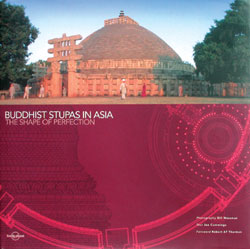 The Buddha said, "The path to nirvana is enlightenment." That may have been just what author Joe Cummings and photographer Bill Wassman were after in the more than eight years they spent researching the and author Joe Cummings of the part-philosophical, part-coffee table book Buddhist Stupas in Asia: The Shape of Perfection. Published by the international guidebook purveyors Lonely Planet, the volume has just been released in Nepal and is sure to be a bestseller.
The Buddha said, "The path to nirvana is enlightenment." That may have been just what author Joe Cummings and photographer Bill Wassman were after in the more than eight years they spent researching the and author Joe Cummings of the part-philosophical, part-coffee table book Buddhist Stupas in Asia: The Shape of Perfection. Published by the international guidebook purveyors Lonely Planet, the volume has just been released in Nepal and is sure to be a bestseller. Cummings and Wassman, both well known names in the travel guidebook industry, and both devout Buddhists, began their journey in the late 1960's when they realised that there were more ways to happiness than the West offered.
Cummings was a political science student in North Carolina when he came to his own realisation. On his first day at college in 1970, he recalls thinking about America's involvement in Vietnam, "I had to establish myself as a moral object," he says. He began searching for more information on the East and later came to Thailand as a Peace Corps volunteer. Eventually there came a Master's degree in Asian art history and Thai language from the University of California at Berkley, followed by more than 35 works on Thailand, Laos, Myanmar and other south-east Asian countries. Not surprisingly, Cummings is today considered an expert on the area.
Trekking in Helambu in the mid-1970's, Wassman realised his calling was capturing moments of life in pictures. He began as an amateur photographer and soon worked his way to professional standards. In 1987, he won the Pacific Area Travel Association (PATA) Gold Award for his story on Pashupatinath and was one of the 50 photographers chosen to cover Thailand for the Kodak-sponsored Seven Days in the Kingdom. Since the eternal eyes of Swoyambhunath first stared back at him in 1968, Wassman has had a rather strong case of obsession with stupas. But it wasn't until about a decade ago that he began working on an entire book dedicated to these architectural masterpieces. Wassman was journeying across Asia, staring into its very soul, when he ran into Cummings at a festival in southern Laos in 1998. That, he decided, was what he needed, a master in the subject to write about what he was photographing.
That old clich? about not judging a book by its cover is right on about Buddhist Stupas in Asia. It may look like just another glossy on Asia, but the talented duo have managed to judiciously balance eye-candy with little-known facts and theories. The book covers 11 Asian nations from Japan to Afghanistan, where the Bamiyan Buddhas are now just a memory. With a foreword by the renowned American authority on Buddhism, Robert Thurman, Buddhist Stupas in Asia attempts to explain the essence of a stupa, the soul, something the collaborators on this volume feel the many modern stupas sprouting all over the globe lack.
"The stupa needs a soul. The new stupa being built in Godavari certainly has one and transcends politics," says Wassman, referring to the new structure being built in Lalitpur, which is inspired by Burmese, Tibetan and Nepali designs.
Although Cummings says he writes "as an art historian", he is quick to add that for him, personally, stupas are more than just works of art. It is this combination of the aesthetic and the academic that is the book's biggest strength, and sets the tone for what it attempts to do-illustrate the different ways that Buddhist communities across Asia have understood the teachings of the master through the difference in the architectural design of stupas.


